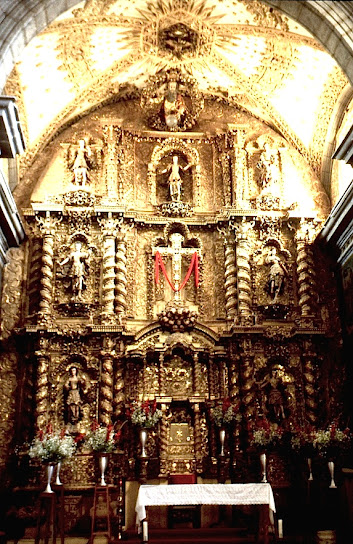 |
| painting: Tecali, Puebla |
 |
| mural: Teabó, Yucatán (Jerome with book, pen, lion and trumpet) |
As a result, Jerome is often represented in western art as one of the four Doctors of the Latin Church (along with Saints Augustine, Ambrose, and Pope Gregory I.) usually seated with a pen and book. He frequently appears with the other Doctors on the predellas of major altarpieces in colonial churches.
altarpieces: San Felipe de Los Alzate, and Tupataro (Michoacan)
Jerome is frequently accompanied by a lion, in reference to the popular belief that he had tamed a lion in the wilderness by healing its paw. This story may have been conflated with the second century Roman tale of Androcles.
mural: Purificación Teotihuacán; altarpiece: Mani, Yucatán
As a secretary to the pope Damasus 1 (a.d. 366 - 384) he has often been portrayed anachronistically as a cardinal, often with a red, tasseled cardinal’s hat (also the insignia of the eremitic Hieronymites or Order of St. Jerome closely associated with the Spanish Augustinians)
Because of the latter years he spent as a hermit and penitent in the desert, he is often depicted as a half-clad anchorite with a crucifix, skull and Bible in his cell or cave in the wilderness. In this role he is usually portrayed kneeling while beating his naked chest with a rock, as he contemplates the suffering Christ on the cross.
 |
| Tlacochahuaya, Oaxaca. facade statue |
He is sometimes depicted with an owl, representing wisdom and scholarship, and a trumpet as a symbol of God’s Word and of Judgment Day.
 |
| Santa Mónica, Hidalgo. relief |
 |
| San Jerónimo Coyula, facade gable with penitent statue of Jerome, and lion relief |
In popular Mexican art he is portrayed with at least one or several of these attributes.
 |
| Big and Little St Jerome, Yaxcopoil, Yucatán |
text © 2017 Richard D. Perry.
images by the author, ©Niccolo Brooker and online sources.
images by the author, ©Niccolo Brooker and online sources.
see our earlier posts on popular and less well known saints as portrayed in Mexico:











